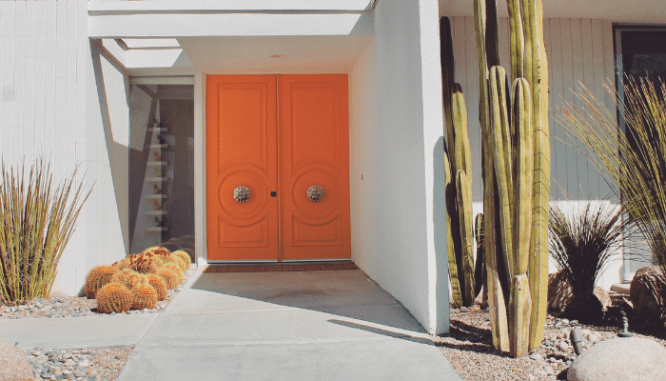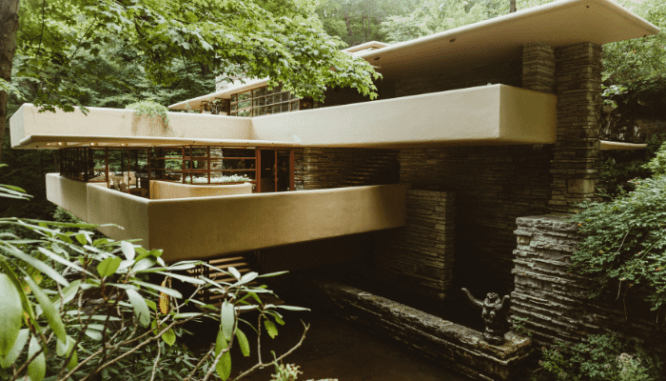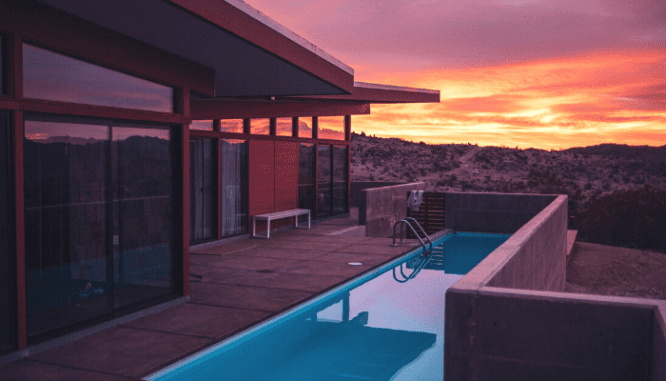What Is Midcentury Modern Architecture? Clean Lines Are Only the Beginning of This Timeless Style
- Published on
- 5 min read
-
 Ashley Simon Contributing AuthorClose
Ashley Simon Contributing AuthorClose Ashley Simon Contributing Author
Ashley Simon Contributing AuthorAshley Simon is a content marketing writer based out of Chicago. She specializes in real estate, home improvement and decor, construction technology, gardening, finance, and international travel.
For many of us, home is an oasis: a place to relax and unwind after a hectic day. And there’s perhaps no design style that embodies tranquility and rest better than midcentury modern design. Characterized by their clean lines, oversized windows, and minimal decorations, midcentury modern homes are an attractive choice for many.
Still, the design style can be a little hard to pin down. Nowadays, it seems that every rug, desk, and pendant light is being advertised as midcentury modern. And it goes without saying that the style bears similarities to a lot of other design trends, such as Hygge or contemporary design. But what is midcentury modern architecture, exactly? Is it a timeless design style, or is it fading into the rearview?
To bring you this guide, we spoke to real estate agent Laura McKenna, a top relocation specialist in the Concord, Massachusetts, area. Read on to learn more about the design influences, unique characteristics, and potential concerns to keep in mind when you’re shopping for a midcentury modern home.

What is midcentury modern architecture?
Originally, midcentury modern architecture referred to any home that was built between the 1930s until about 1965. But the term was actually coined about 20 years after the era, in 1984, when Cara Greenburg used it in the title of her book, Mid-Century Modern: Furniture of the 1950s. Today, midcentury modern can be used to refer to a style of architecture or interior design.
Midcentury modern influences
One of the beautiful things about midcentury modern architecture is that it comes in many different forms. Here are the architectural styles that have had the greatest impact on midcentury modern design.
Prairie style
One major influence of midcentury modern architecture were the Prairie style homes of the early 1900s. This architectural style emphasized long, low, horizontal lines instead of vertical ones. The style married modern elements with a celebration of nature. It became popular in the 1900s by architects like Frank Lloyd Wright.
International Style and the Bauhaus movement
Developed throughout the 1920 and 1930s, International Style was an architectural movement that centered around function. It was influenced heavily by a school of design called Bauhaus that was founded in Germany at the same time. Both movements frowned on color and ornamental decorations, instead leaning heavily on industrial, mass-produced elements.
This way of approaching architecture was not loved by everyone. Many critics of the time felt that the International and Bauhaus styles were too impersonal and cold. But these movements had a significant impact on modern home design.
Scandinavian design
Minimal and stripped back, Scandinavian design has become especially trendy in recent years, and it’s gone a long way toward making midcentury modern more popular. It incorporates natural, monochromatic colors and light-filled spaces.
The main difference is that Scandinavian design has a greater emphasis on light colors and natural light. Midcentury modern design can use the same colors, but it also works well with dark colors and darker rooms.
Contemporary design
Contemporary design incorporates more ornamental decorations than midcentury modern. Lines tend to be softer and curved, as opposed to the straight lines and angles of midcentury modern style.
Organic architecture
Organic architects draw inspiration from the natural environment when designing buildings. Though he was not the first, Frank Lloyd Wright is one of the most well-known organic architects. Wright and others like him incorporate lots of natural light into the design of organic houses. Colors are always natural and often drawn from the surrounding environment. The design is simple, clean, and peaceful, often blending indoor and outdoor spaces.

Defining characteristics of midcentury modern architecture
According to Dominic Bradbury, author of Atlas of Mid-Century Modern Houses, the midcentury period was one of the most dominant styles in the 20th century. If you’re thinking about renovating parts of your house in midcentury style, use this list of common features for inspiration.
Large windows
Most midcentury homes are built with nature in mind, and that means tons of natural light is incorporated into the design. Sweeping, floor-to-ceiling windows are a hallmark of these homes, and they let light flow in from every direction.
If you’re buying an older house, McKenna suggests checking to make sure the windows are double-pane. She also encourages buyers to think about which direction the sun will rise and set before they purchase a home with large windows. This will affect your energy bills!
Split-level design
Many midcentury homes feature open-concept interiors with short staircases and split levels to separate the rooms. Master bedrooms are often on the second floor, and some houses even have multiple staircases with bedrooms on different levels.
Some homes feature bedrooms on a lower level, which are often covered by a deck or patio. While this can open up more outdoor space, McKenna sees a lot of buyers who are disappointed in the lack of light coming into the bedrooms. In these cases, she recommends taking off the deck and turning it to the other side of the house, then adding a skylight to the bedroom.
Open-concept furnishings
Midcentury homes are built with minimal decoration, but this doesn’t mean the house lacks beauty. Functional pieces of furniture often double as pieces of art, such as open-riser staircases that catch the morning light, or geometric ‘50s-style chairs.
Flat roofs
Midcentury homes are characterized by their long, horizontal roofs. The roofs always have a slight angle to keep snow and debris from collecting on the top, but they don’t have the triangular peaks of a traditional roof.
Natural and bright colors
You’ll see lots of muted colors such olive green, earthy browns, and cloudy grays in classic midcentury homes, but the era did not shy away from bright pops of color such as lipstick reds and bold yellows. When in doubt, go with a clean, pure white.
Emphasis on the outdoors
Nature factors heavily into midcentury architecture. Many homes have huge windows that allow you to see the outdoors, and sliding doors and patios blend the boundary between indoors and outdoors.

Where can I find homes with midcentury modern architecture?
Whether you’re looking to buy a home or just wanting to appreciate the beauty of a historical landmark, there’s no shortage of midcentury homes across the U.S. Palm Springs, California, is widely recognized as a mecca for midcentury modern architecture. It has the largest concentration of midcentury modern architecture in the world, with many historic homes built by famous architects.
Austin, Texas, also has a great deal of historic homes in midcentury style. For homebuyers, check out Starlight Village, an up-and-coming neighborhood with the motto “Where mid-century cool meets 21st century living.” In Chicago, you’ll find midcentury modern treasures designed by Frank Lloyd Wright, Bertrand Goldberg, and Mies van der Rohe.
If you’re just wanting to appreciate some historic beauty, you might consider visiting the Neutra VDL Studio and Residences. Located in Los Angeles, the house was built in 1932 by Viennese-American architect Richard Neutra as a home for his wife and three sons. It was designated as a National Historic Landmark in 2016, and remains open to the public for tours.
Another famous example is Philips Johnson’s Glass House in New Canaan, Connecticut. Made entirely of glass, this one-room structure blends seamlessly into its environment. Rooms are suggested with furniture and rug placement, rather than walls.
Built in the 1950s by Ludwig Mies van der Rohe, the Farnsworth House is located in Plano, Illinois. The structure was completed in International Style, and features a horizontal slab roof that runs parallel to the floor. The walls are made of glass, creating a structure that is highly functional and filled with light.
Potential concerns
When it comes to interior design, midcentury style is perfect for busy, career-focused individuals. It requires minimal upkeep, thanks to the lack of elaborate decorations. The clean lines and emphasis on the outdoors create a soothing, refreshing environment.
Still, there are some concerns to keep in mind. McKenna advises families to be cautious about homes with open-riser staircases. The large gaps between each stair step are wide and can pose a trip hazard for small children. She also tells buyers to be careful about purchasing a house with too many trees around it.
“Midcentury is all about sunlight and nature,” says McKenna, “but too much vegetation is not good for the roof. You need airflow in order to prevent mold and moss.” If a home has too many overhanging branches from nearby trees, she recommends trimming them back.
If your midcentury home has a flat roof, you should watch out for standing water, snow, or debris. Call a professional right away if you notice a buildup. Although most flat roofs are built with a slight angle to allow for proper drainage, they tend to be more susceptible to problems. Experts recommend replacing flat roofs every 10 years instead of waiting the standard 15 years.
Finally, McKenna recommends checking the windows to make sure they are double pane. If your home has vintage windows, they may lack the proper insulation. In many cases, a good window contractor should be able to repair or replace your windows without damaging the structure.

Is midcentury modern going out of style?
Designers are split on this question. A handful of critics say that midcentury modern is a passing trend. Many others, including Christopher Kennedy, designer and author of Making Midcentury Modern, point out that this “trend” has been around for years.
McKenna agrees with Kennedy. “Midcentury modern will always be in style,” she says. “Maybe not with everyone, but there will always be a following.” If you love the idea of practical design, ample sunlight, and artistic beauty, a midcentury home might be right for you. Reach out to an agent in your area to learn more about the midcentury modern homes near you.
Header Image Source: (Cody Board / Unsplash)
